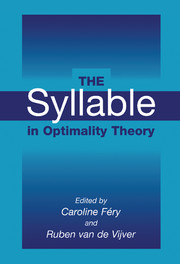Book contents
- Frontmatter
- Contents
- List of Contributors
- Preface
- The Syllable in Optimality Theory
- Part One INTRODUCTION
- Part Two SYLLABLE STRUCTURE AND PROSODIC STRUCTURE
- Part Three NONMORAIC SYLLABLES AND SYLLABLE EDGES
- Part Four SEGMENTS AND SYLLABLES
- 11 On the Sources of Opacity in OT: Coda Processes in German
- 12 Ambisyllabicity and Fricative Voicing in West Germanic Dialects
- 13 The CiV-Generalization in Dutch: What Petunia, Mafia, and Sovjet Tell Us about Dutch Syllable Structure
- 14 The Relative Harmony of /s+Stop/ Onsets: Obstruent Clusters and the Sonority Sequencing Principle
- Part Five HOW CONCRETE IS PHONOTACTICS?
- Author Index
- Languages Index
- Subject Index
14 - The Relative Harmony of /s+Stop/ Onsets: Obstruent Clusters and the Sonority Sequencing Principle
Published online by Cambridge University Press: 03 July 2009
- Frontmatter
- Contents
- List of Contributors
- Preface
- The Syllable in Optimality Theory
- Part One INTRODUCTION
- Part Two SYLLABLE STRUCTURE AND PROSODIC STRUCTURE
- Part Three NONMORAIC SYLLABLES AND SYLLABLE EDGES
- Part Four SEGMENTS AND SYLLABLES
- 11 On the Sources of Opacity in OT: Coda Processes in German
- 12 Ambisyllabicity and Fricative Voicing in West Germanic Dialects
- 13 The CiV-Generalization in Dutch: What Petunia, Mafia, and Sovjet Tell Us about Dutch Syllable Structure
- 14 The Relative Harmony of /s+Stop/ Onsets: Obstruent Clusters and the Sonority Sequencing Principle
- Part Five HOW CONCRETE IS PHONOTACTICS?
- Author Index
- Languages Index
- Subject Index
Summary
Introduction
The organization of segments within the syllable and across syllables is traditionally assumed to be driven by principles of sonority, a property that ranks segments along a scale from most sonorous to least sonorous. Although the nature of sonority itself is highly controversial, a fairly uncontroversial scale ranks stops, fricatives, nasals, liquids, glides, and vowels in order of increasing sonority, as shown in the scale in (1):
(1) Stops < Fricatives < Nasals < Liquids < Glides < Vowels
A number of cross-linguistic tendencies on the distribution and sequencing of segments is expressed with reference to sonority scales of the type in (1). In particular, the Sonority Sequencing Principle (SSP) (Hooper 1976, Kiparsky 1979, Steriade 1982, Selkirk 1984, Clements 1990, Zec 1995, among others) states that in a syllable, the segment ranking highest on the sonority scale constitutes the syllable peak, with all other segments organized around it in such a way that the most sonorous segments are closer to the peak and the least sonorous ones are farthest away from it.
A relatively significant number of languages show the phonotactic pattern in (2), whereby three basic types of consonant clusters occur in the onset.
(2) a. Stop + Sonorant
b. Fricative + Sonorant
c. Fricative + Stop/(Fricative)
- Type
- Chapter
- Information
- The Syllable in Optimality Theory , pp. 356 - 372Publisher: Cambridge University PressPrint publication year: 2003
- 9
- Cited by



